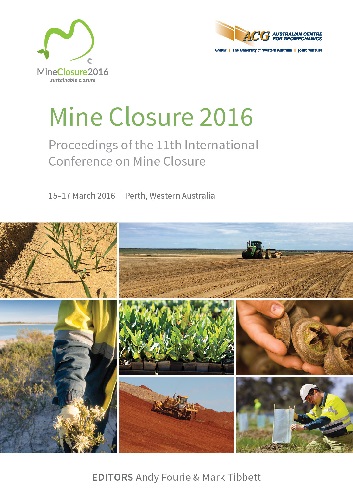Passive treatment of acid mine drainage at Vryheid Coronation Colliery, South Africa

|
Authors: Pulles, W; Lodewijks, HM; Toerien, A; Muhlbauer, R; van Niekerk, JA; Richardt, A |
DOI https://doi.org/10.36487/ACG_rep/1608_31_Pulles
Cite As:
Pulles, W, Lodewijks, HM, Toerien, A, Muhlbauer, R, van Niekerk, JA & Richardt, A 2016, 'Passive treatment of acid mine drainage at Vryheid Coronation Colliery, South Africa', in AB Fourie & M Tibbett (eds), Mine Closure 2016: Proceedings of the 11th International Conference on Mine Closure, Australian Centre for Geomechanics, Perth, pp. 425-438, https://doi.org/10.36487/ACG_rep/1608_31_Pulles
Abstract:
A novel passive bio-neutralisation water treatment process has been applied to treat an acidic mine drainage decant emanating from a closed colliery in northern KwaZulu Natal, South Africa. The process has been implemented to treat 200 m³/day of water and incorporates the following components: a 3.2 km pipeline from the decant point to the water treatment site, a molasses dosing station, a 1,000 m³ bio neutralisation reactor, three aeration cascades to oxidise sulphides, passive sulphide gas extraction to a bio filter to oxidise sulphide gas, three limestone reactors for pH polishing, and an aerobic wetland to remove residual nutrients. The bio-neutralisation technology is a strictly biological process utilising bacterial processes to treat an influent with a pH as low as 2.8 to remove the acidity, iron and aluminium. The plant has already been constructed and commissioning commenced in August 2015.
Keywords: passive treatment, acid mine drainage, coal mining
References:
Coetser, SE, Pulles, W, Heath, R & Cloete, E 2006, ‘Chemical characterisation of organic electron donors for sulphate reduction for potential use in acid mine drainage treatment’, Biodegradation, vol. 17, no 2, pp. 169–179.
Gusek, JJ 1998, ‘Three case histories of passive treatment XE "Passive treatment" of metal mine drainage’, in Proceedings of the 19th Annual West Virginia Surface Mine Drainage Task Force Symposium, West Virginia University, Morgantown, West Virginia XE "USA" .
Kolmert, A & Johnson, DB 2001, ‘Remediation of acidic waste waters using immobilised, acidophilic sulphate-reducing bacteria’, Journal of Chemical Technology and Biotechnology, vol. 76, pp. 836–843.
Lamb, HM, Dodds-Smith, M & Gusek, J 1998, ‘Development of a long-term strategy for the treatment of acid mine drainage at Wheal Jane’, in W Geller, H Klapper & W Salomons (eds), Acidic mining lakes: Acid Mine drainage, Limnology and Reclamation, Springer, Heidelberg, pp. 335–346.
Mack C-L, Raja, S, Pulles, W, Muhlbauer, R & Heath, R 2009, ‘Application of the linear flow channel reactor (LFCR) for the removal of sulphide from semi-treated acid mine drainage (AMD)’, in Proceedings of International Mine Water Conference, South Africa.
Molwantwa, JB & Rose, PD 2013, ‘Development of a Linear Flow Channel Reactor for sulphur removal in acid mine wastewater treatment operations’, Water SA, vol. 39, no. 5, pp. 649–654.
Molwantwa, JB, Coetser, SE, Heath, R & Rose, P 2004, ‘Development of the floating sulphur biofilm reactor for sulphide oxidation in biological water treatment systems’, in Proceedings of the Water Institute of South Africa Biennial Conference, South Africa.
Molwantwa, JB, Coetser, SE, Heath, R, Pulles, W & Bowker, M 2010, ‘Monitoring, evaluation and verification of long-term performance of the passive water treatment plant at Vryheid Coronation Colliery’, Water Research Commission Research Report No.1623-1-10.
Muhlbauer, R, Raja, S, De Villiers, D, Pulles, W, Clark, S & Heath, R 2010, ‘Implementation of a demonstration scale Integrated Managed Passive (IMPI) process’, in Proceedings of the International Mine Water Conference, Nova Scotia, Canada.
PIRAMID (Passive in-situ remediation of acidic mine/industrial drainage) Consortium 2003, Engineering guidelines for the passive remediation of acidic and/or metalliferous mine drainage and similar wastewaters, PIRAMID Consortium (ed.), European Commission 5th Framework RTD Project no. EVK1-CT-1999-000021, University of Newcastle Upon Tyne, Newcastle Upon Tyne UK. p. 166.
Pulles, W & Heath, R 2009, ‘The evolution of passive mine water treatment technology for sulphate removal’, in Proceedings of International Mine Water Conference, South Africa.
Pulles, W, Coetser, SE & Heath, R 2004, ‘Development of high rate passive sulphate reduction technology for mine waters’, in Proceedings International Mine Water Association Symposium, United Kingdom, vol. 1, pp. 253–262.
Pulles, W, Rose, P, Coetser, SE & Heath, R 2003, ‘Development of integrated passive water treatment systems for the treatment of mine waters’, in Proceedings of 6th International Conference on Acid Rock Drainage (ICARD), Australia.
van Hille, RP, Van Wyk, N, Motleleng, L & Mooruth, N 2011, ‘Lessons in passive treatment: Towards efficient operation of a sulphate reduction - sulphide oxidation system’, in Proceedings of the International Mine Water Conference, Germany.
Willow, MA & Cohen, RHH 1998, ‘pH XE "pH" and dissolved oxygen as factors controlling treatment efficiencies in wet substrate, bio
reactors dominated by sulfate reducing bacteria’, in XE "Microbial processes" “Tailings and Mine waste ‘98” (Symposium Volume of the American Society for Surface Mining and Reclamation).
© Copyright 2025, Australian Centre for Geomechanics (ACG), The University of Western Australia. All rights reserved.
View copyright/legal information
Please direct any queries or error reports to repository-acg@uwa.edu.au
View copyright/legal information
Please direct any queries or error reports to repository-acg@uwa.edu.au